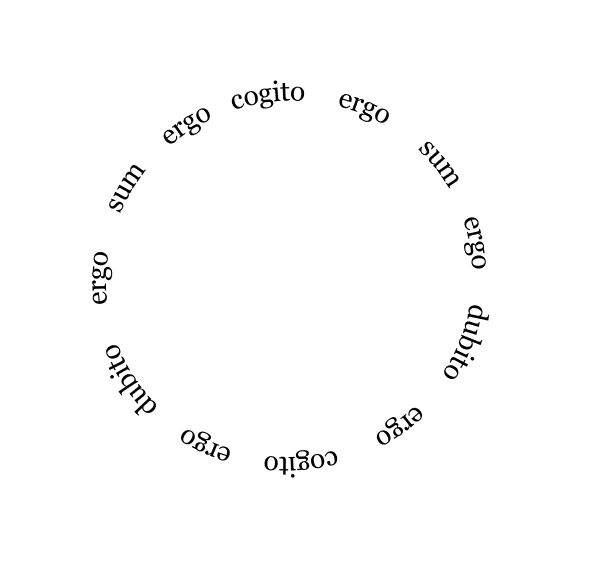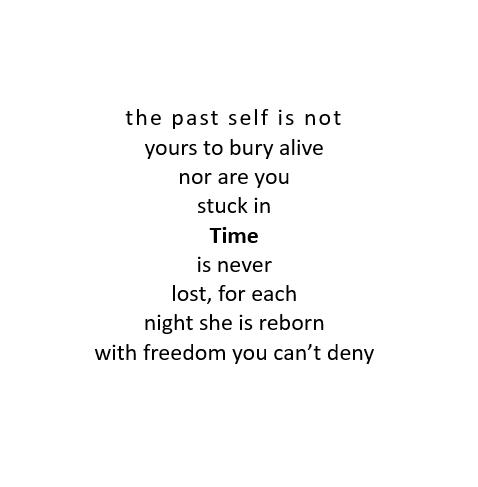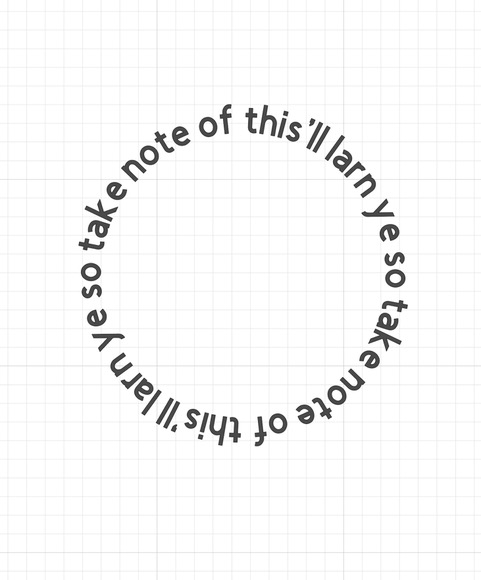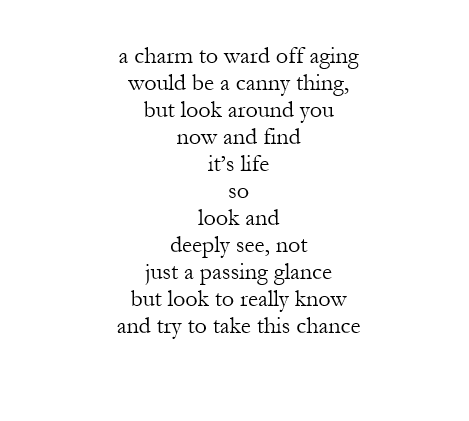This is part two of a two-part reflection on Rebecca’s Writing Transformation workshop. You can find part one here.
If this inspires you, Rebecca will be running the workshop again – with a new part added – for St Andrews students, on Friday 10th November, 5-8pm at St Andrews Student Union (in-person only). Free to attend but booking required.
The Workshop
I find the process of devising a new workshop and constructing the material to be incredibly creatively satisfying. I especially appreciate the social aspect of workshops, meeting different people within the shared space of creativity, in this case, poetry. I’m also passionate about empowering others to overcome any lack of confidence around creative practice, especially poetry. Concrete and visual poetry can take some of the heat out of putting pen to paper, that fear of ‘getting it wrong’. It can create a helpful space between ‘what I want to say’ and ‘how I’m going to say it’; and can also be treated as a testing ground towards a later (even non-concrete) piece of work. And for participants who have no immediate intention to write another poem beyond the workshop, I’m fascinated to hear the ways that poetry can be used as a thing to think with, perhaps being applied within another field of practice.
In Writing Transformation, we focused on three forms: the circle (and spiral), hourglass, and contrapuntal.
- I demonstrated the spiral form previously (in Part One, What drilling does, II). The circle form holds the idea of repetition differently: as a cycle, an ouroboros, the end feeding back into the beginning. Indeed, when a circle poem is working well, the ‘beginning’ and the ‘end’ disappear altogether. This is an ideal form with which to explore themes of time and other natural cycles, currency, circularity, movement or momentum, change or indeed, constancy.

- For the hourglass poem, you’ll see I’ve borrowed from the basic form of my poem E= (see Part One) but here, made semi-concrete (more ‘written’): expanding from single letters to words. I’m also alluding to the Extinction Rebellion logo in both cases.

The Extinction Rebellion logo: a circle represents the planet, with a stylised hourglass to symbolize time and resources running out.The symbol dates to at least 2012 and has been attributed to anonymous East London artist Goldfrog ESP. It has been called this generation’s peace sign.
Taking all the damage done
as a cycle ended,
errors made, not
to be
repeated,
then all
our efforts now
to reclaim time and
consciousness are for the giving.
The hourglass or ‘Extinction Rebellion’ poems as we called them in the workshop, come with useful rules (sharing ground with other forms that work with syllable or wordcount): (1) the lines diminish from 5 words into the centre (1 word), then increase out again 1-5. (2) The central word should therefore carry added significance, like a hinge, a tipping or pivot point. And (3) there should be some difference in tone between the top and bottom parts of the poem: something diminishing then growing again, perhaps – a shift of momentum or perspective, maybe a change of heart. From there, look for ways to refine the poem as you wish. My own example here, written for the workshop, isn’t perfect – but at least demonstrates what’s at play.
- A contrapuntal (counterpoint) poem interweaves two or more poems via columns or sections on the page, that appear to be asking to be read at the same time. Our inability to do this creates a sense of tension, duality, conflict or dilemma, which is often at the heart of the poem. To illustrate, we looked at Notes on My Present: A Contrapuntal by Natalie Scenters-Zapico, which can be found here.
I incorporated an extra element to this exercise: the use of tarot cards as visual prompts for our two columns. The Chariot card (number 7 in the Major Arcana), and its numerological ‘shadow’, The Tower (16).


With no knowledge of tarot required (beyond the outline I provided in the workshop), the task was to respond to each image instinctively and imaginatively, purely as a visual object. On the one side (Chariot), we have the idea of harnessing our focus, efforts and resolve towards a possibly far-off goal or higher purpose; while on the other side (Tower) we see fear, chaos, everything seemingly falling apart – though very possibly the structure we’re shown has outgrown its purpose and needs to come down in order for us to rebuild.
These seemingly opposing energies of determination and fear, creation and destruction, felt pertinent to our purposes. The invitation was to write responses for each column / card, looking out for points of correspondence or divergence between them, that we might exploit for structural and poetic effect. Being the most ‘written’ of all the exercises, there was no expectation of filling the page within the time given – this was more likely going to be one to take home and finish later.
The Work:
I’m honoured and delighted to share here some thoughts and feedback from participants of both the in-person and online workshops – as well as some of the work created (sharing was entirely optional), generously provided with the permission of the writers. It’s impossible to overstate how much I value this strand of my work: the privilege of sharing ideas and theories, learning from each other. And the inspiration I receive in return, finding out about each other’s practices, hearing how the material lands with other people, and how it might continue to resonate far beyond our short time together. With my utmost thanks and appreciation to all the participants, including those not named below – for your time, attention, trust and creativity. All power to your pens.
Jingjing Ma: three poems



Karen Macfarlane: cycle and anti-cycle

Felix Schiedlowski used circular poems to address themes of energy transition:

Kathryn Holme found that her poems expressed her current feelings about a shift of family dynamics, with her eldest son starting University:

Terra Rowe:

“I wrote this poem shortly after the workshop when I was reading Jane Bennett’s The Enchantment of Modern Life. I was inspired by the following: Bennett’s quoting Deleuze and Guattari, quoting Kafka: “Kafka tells how, as a child, he repeated one of his father’s expressions in order to make it take flight on a line of non-sense: ‘end of the month, end of the month’ (21)” (154).”
Ian Ledward based this contrapuntal ekphrastic poem on the source images (tarot cards), and his own existing artwork:

Ian Ledward: this’ll larn ye and A Charming Thought


Freya Payne wrote this poem – The wind leaves me hieroglyphics – after the workshop, thinking about form lending meaning, and reading the inner from the outer experience:

Reflections:
“I am an anthropologist and trying to make sense of the transition to a post-carbon society in Eastern Germany for my PhD. The workshop helped me to think about and work with my material creativity. I will certainly use these methods again! The editing process of my circular poem was also very, very helpful and gives me indeed some new ideas about the [transition] ‘gap’, which is central as a theoretical argument in my PhD work.” Felix Schiedlowski, Martin Luther University, Halle-Wittenberg.
“I thoroughly enjoyed it. I’d love to see more of these kinds of workshops offered to non-literature scholars—it’s great to be challenged to think in different modes and rhythms.” Terra Schwerin Rowe, Associate Professor, Philosophy and Religion Dept, University of North Texas.
“I am an EARTH Scholar at the University of Edinburgh, thinking about arts practice, embodiment and place-based environmental ethics, and I found your approach very compelling. I am thinking with poetry, and ecopoetry is particular, what different poetic styles can do for environmental relating.” Aadita Chaudhury, University of Edinburgh.
“I’m fairly concerned with external and ‘objective’ achievement, when those concerns detract from actual attention and diligence to the work I care about. So, I went into the exercises worried that I would fall short of this imagined threshold I had created and couldn’t locate, but they soon melted away when I discovered the fun of doing it myself. Turns out whatever words coming out of unpredictable reactions in my brain will always be meaningful to me. I was scared that I would be bad, but soon found that I didn’t care that I probably am. I was able to put away my judgment, for both others and myself, and that felt great.” Jingjing Ma, University of St Andrews.
“I just wanted to let you know how much I got out of the online workshop – I’ve really enjoyed playing with what forms can do to the ideas in a poem.” Karen Macfarlane, poet.
“I found the experience of working with you and the group very powerful, transformative and wholesome. I am making little pockets of time to be playful with words… The structure of the workshop and your generosity in sharing your methods was so impactful.” Susie Johnston, artist and PhD researcher, Duncan of Jordanstone College of Art.
“I’ve never done a poetry workshop before, so wasn’t sure what to expect. You did a great job welcoming everyone in and I felt reassured and safe in the room. I enjoyed the thematic structure, the information you gave around each concept, and the exercises you offered. I loved learning the language/terminology/history you shared around poetry; the access you gave to your own practice and that of other poets.” Freya Payne, artist.
© the contributors 2023



